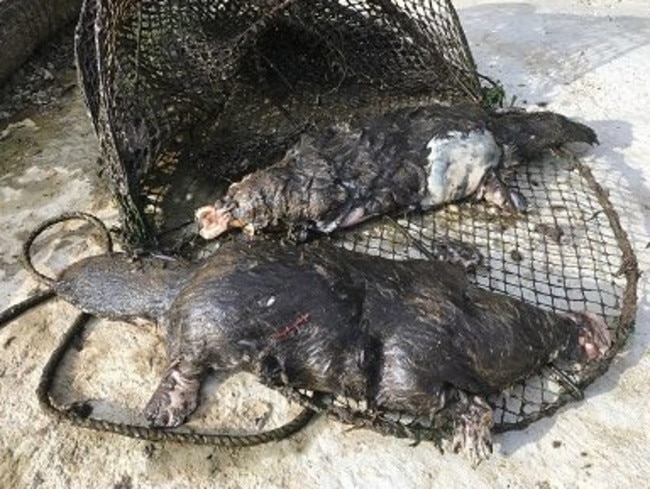‘It’s simply not good enough … to be leaving the next generation with a crisis like this’
AMID a new call for an inquiry into Australia’s animal extinction crisis, experts worry that even one of our most iconic animals isn’t safe. WARNING: Distressing image.
WARNING: Distressing image.
WHEN it comes to the loss of biodiversity, Australia has one of the worst records in the world, losing more mammals and plants in the past 200 years than any other country.
Now a Senate inquiry is set to address the issue.
Roughly 11 per cent of Australia’s 273 endemic land mammal species are already extinct, according to a 2015 study.
Experts say efforts to reverse course are hampered by lack of funding, cuts to environment department budgets, poor co-ordination between state and federal departments, a lack of accountability and failure to implement comprehensive management plans for species.
On Wednesday, the Senate launched an inquiry into our extinction rate, with the vote initiated by Greens senator Janet Rice and supported by Labor and crossbenchers.
Ms Rice said the country was facing an “animal extinction crisis” and accused the Government of standing by while more species marched towards their demise.
“A staggering one in three global mammal extinctions in the last 400 years have occurred in Australia,” she said.
“It’s simply not good enough for a country as advanced and wealthy as ours to be leaving the next generation with a crisis like this.
“We urgently need this inquiry to identify the funding resources and legal protections that have to be in place to ensure that not one more animal species goes extinct in Australia.”
It will be the second such inquiry in six years.
It’s not just little-known invertebrates, microorganisms and plant species that are at risk of disappearing. Surprisingly, experts say we’re also in danger of seeing one of our most iconic species face the real threat of extinction — the platypus.

Platypuses are predominantly found along the Great Dividing Range across eastern Australia but in recent times researchers seen the marsupial’s numbers decline. The species is an elusive and nocturnal animal and signs of dwindling numbers are concerning conservationists.
Speaking to RN Breakfast on ABC Radio this morning, Professor Richard Kingsford, director of the Centre of Ecosystem Science at the University of NSW, said we’re on a worrying “downhill slide” when it comes to our biodiversity “across all the major realms” of our ecosystem.
His research suggests the platypus could soon find itself on the list of threatened species.
“We are currently working on a research project on the platypus and coming up with some alarming indicators about its status,” he said.
“It’s one of those species that everyone says is ubiquitous but we’re concerned about numbers.”
The International Union for Conservation of Nature (IUCN) red list of threatened species recognises the platypus as “near threatened” but Prof Kingsford said Australia could soon need to recognise the potential threat facing the animal.
“It probably won’t be long before they’ll need to be considered for our national list,” he said.
Most species decline is driven by degradation and habitat loss, but for the platypus, it’s often hazards left by humans that causes the problems, according to biologist Geoff Williams, a member of the Australian Platypus Conservancy.
“The problems with many of these populations is death by a thousand cuts — there are quite a large number of platypuses being entangled in litter, particularly discarded fishing line, and die an unpleasant death … and animals dying in illegally placed fishing traps, particularly yabby traps,” he told National Geographic last year.
Despite the fact that opera house yabby traps which can kill platypuses are illegal to use in public rivers and creeks in most parts of the country, the Conservancy’s Facebook page is filled with photos showing the damage they can do, killing the animals that get trapped.

FIGHTING BACK
Conservationists have been sounding the alarm about biodiversity loss for years.
“We’re in a situation that is spiralling out of control. I don’t want to be too superlative or sensationalist about it, but we’ve been saying this for so long and yet every single index we’re looking at is getting worse and it’ll only continue to do so,” Professor Corey Bradshaw, a fellow in global ecology at Adelaide’s Flinders University told news.com.au in May.
Despite our already disappointing record, he believes things are only going to get worse.
“I suspect we’re just starting to see the first wave of extinctions,” Prof Bradshaw said. “We’re already leading the world in mammal extinctions — not something we should be terribly proud of.”
The Government has said there are recovery plans in place for nearly all threatened species and has earmarked more than $255 million in funding to preserve our biodiversity through 1200 different projects.
In December, it appointed Dr Sally Box as Australia’s new Threatened Species Commissioner.
According to the announcement at the time, the commissioner’s job is to champion the implementation of the Threatened Species Strategy which has a focus on preserving 20 mammals, 20 birds and 30 plants.
Writing for Fairfax in May, Environment Minister Josh Frydenberg said protecting our threatened species was a national priority.
“Today, 99.7 per cent of around 2000 of the threatened species and ecological communities listed under the Environment Protection and Biodiversity Conservation Act have a recovery plan or conservation advice, with our aim of achieving 100 per cent shortly,” he wrote.
Mr Frydenberg said the Government is committed to the practical conservation actions to recover our most threatened plants and animals.
“In every case, where appropriate, we seek to galvanise the expertise and efforts of indigenous rangers, native title holders, State Governments and not-for-profit organisations,” he wrote.
However Prof Kingsford told the ABC he would like to see more being done and encouraged State Governments to become more involved saying the current measures at a federal level “aren’t at all enough”.




